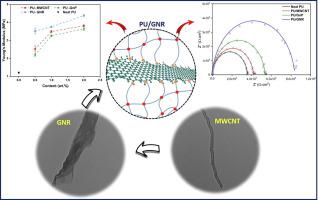Chemical Engineering Journal ( IF 15.1 ) Pub Date : 2020-09-15 , DOI: 10.1016/j.cej.2020.126858 Saeed Habibpour , Jun Geun Um , Yun-seok Jun , Priya Bhargava , Chul B. Park , Aiping Yu

|
In this study, graphene nanoribbon (GNR) was produced through oxidative unzipping of multiwalled carbon nanotube (MWCNT) to integrate high aspect ratio features of MWCNT with a planar structure of the graphene. Afterward, its structural effect (shape and aspect ratio) on mechanical and anti-corrosion performance of polyurethane (PU) nanocomposites was thoroughly investigated utilizing uniaxial tensile measurement and electrochemical impedance spectroscopy (EIS). The results were compared to MWCNT with tubular high aspect ratio and graphene nanoplatelet (GnP) with a planar low aspect ratio structure. PU-filler nanocomposites were produced with different nanoparticle loadings and applied to a cold rolled steel substrate for mechanical and anti-corrosion measurements. As a nanocomposite filler, MWCNT performs well in terms of mechanical properties, and GnP shows higher anti-corrosion performance. However, PU-GNR pronounces in both mechanical properties and corrosion resistance. Young’s modulus of 0.5 wt.% PU-GNR nanocomposite reaches 3.52 MPa, which is around 1.6 and 1.4 times higher than the PU-GnP (2.19 MPa) and PU-MWCNT (2.52MPa), respectively. Furthermore, PU-GNR exhibits the highest corrosion resistance of 8.45×105 Ω·cm2 compared to PU-GnP with 5.14×105 Ω·cm2 and PU-MWCNT with 4.09×105 Ω·cm2. The better performance of the PU-GNR nanocomposites is attributed to the planar structure, high aspect ratio, uniform dispersion and better polymer-filler interactions. They contribute to not only improve load-bearing properties of the nanocomposite but also build a tortuous pathway of GNR suppressing corrosive agents’ diffusion to the PU matrix.
中文翻译:

石墨烯纳米带的结构对聚氨酯纳米复合材料力学性能和耐腐蚀性能的影响
在这项研究中,通过多壁碳纳米管(MWCNT)的氧化解压缩生产石墨烯纳米带(GNR),以将MWCNT的高长宽比特征与石墨烯的平面结构整合在一起。随后,利用单轴拉伸测量和电化学阻抗谱(EIS)深入研究了其对聚氨酯(PU)纳米复合材料的机械和耐腐蚀性能的结构影响(形状和长宽比)。将结果与管状高纵横比的MWCNT和平面低纵横比结构的石墨烯纳米片(GnP)进行了比较。生产具有不同纳米颗粒负载量的PU填料纳米复合材料,并将其应用于冷轧钢基材,以进行机械和防腐测量。作为纳米复合填料,MWCNT在机械性能方面表现出色,GnP表现出更高的防腐性能。但是,PU-GNR的机械性能和耐腐蚀性都很高。0.5重量%的PU-GNR纳米复合材料的杨氏模量达到3.52MPa,分别是PU-GnP(2.19MPa)和PU-MWCNT(2.52MPa)的约1.6和1.4倍。此外,PU-GNR的最高耐腐蚀性为8.45×105 Ω ·厘米2与5.14×10相比PU-GNP 5 Ω ·厘米2,并用4.09×10 PU-MWCNT 5 Ω ·厘米2。PU-GNR纳米复合材料的更好性能归因于平面结构,高纵横比,均匀分散和更好的聚合物-填料相互作用。它们不仅有助于改善纳米复合材料的承重性能,而且有助于建立GNR抑制曲折的腐蚀剂向PU基质扩散的曲折途径。


























 京公网安备 11010802027423号
京公网安备 11010802027423号